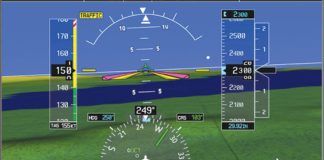Unknown Ice
Last fall as I was departing Reno, NV (KRNO), the weather was 1500 overcast (6000 MSL), tops 10,000 MSL, surface temp +10 C and there was no precipitation. I was flying my pressurized, turbocharged, FIKI-certified Cessna 414. I’d flight planned for FL 190.
I hand flew the departure because that is recommended when potential icing conditions exist. In the climb I noticed light rime ice on the leading edges of the wings. I was watching carefully for decreasing performance (airspeed, rate of climb, etc.) and all seemed quite normal.
Suddenly, without warning, the yoke pulled full forward and began to buffet. I immediately recognized this as a tail stall and simultaneously pulled back on the yoke and hit the surface de-ice switch to inflate the pneumatic boots.
I was tempted to swivel my head around to look at the horizontal stabilizer, but was afraid that such a dramatic head movement would cause vertigo. So, I have no idea how much ice was on the tail, but of course I know that thinner airfoils on the horizontal stabilizers collect more ice than the thicker wings. Fortunately the engineers at Cessna knew that too, because the de-ice sequence inflates the tail boots first. Control returned to normal almost immediately and I continued my climb to on top.
The only thing I forgot was to notify ATC about the ice, so the rest of the pilots behind me did not get warned, leaving the encounter as unknown icing. I know that I am required to report adverse conditions, and can only guess that I was more shaken than I realized.
William Ramos, MD
Las Vegas, NV
Last month we also published a letter from a reader who’d encountered some light ice that caused a tail stall. Although we try to keep our information timely, we honestly had no idea our article about tail stalls could cause an increase in these heretofore relatively infrequent events.
Wow…the power of the press!
Parallel or Tear Drop?
In the June issue’s article “Keeping Time,” the author references the missed approach hold at Bradford and says it is a parallel entry. Isn’t it a tear drop instead?
Mark Sneider
St Louis, MO
The author and subsequently the editor looked at this wrong. We both looked at the depiction and assumed that the course to the holding fix would be 313 degrees—the inverse of the hold inbound course. Thus, either a tear drop or a parallel would be fine.
However, on a proper examination, the missed approach instructions say to make a left turn then fly direct to the VOR, probably on around a 295 course. So, yes, a tear drop entry is the textbook answer.
IFR Gone Well
I enjoyed reading Bill Castlen’s article “IFR Gone Good” in the April issue. I too have experienced similar flights (also in a Cirrus) and have been lucky enough to capture quite a few of the glories on videos. I have also seen a complete-circle real rainbow that felt like it was embracing my airplane. I continue to be awed when I break out at minimums and there is the runway, right where it is supposed to be. It’s a great feeling, indeed.
As I read articles about flying like this, I often want to vicariously relive the experience by plotting the route and approach on ForeFlight. That would be a lot easier if the airports mentioned in the various articles would be identified by their three letter identifier.
Also, by the way, “IFR Gone Well” would be a better title.
David Williams
Roanoke, VA
We’ve had some folks complain about us using all the airport identifiers because they have no idea where the airport is from the identifier. So, we started using actual cities. In an attempt to please more of the people more of the time, we’re now starting to use the city name with the airport identifier in parentheses, but that can create a space issue—sometimes every character counts.
The title was a play on the more common expression, “…gone bad.” We deliberately take a lot of calculated language liberties in the magazine to keep it light and fun so you (readers) can wade through what is often otherwise some rather heavy, sometimes inherently dull, material. In fact, that’s a large part of what sets us apart.
Fly safe(ly).
Nice Weather
I have to compliment Tim Vasquez on his spring weather summary article in the May issue. I always enjoy reading his articles but this one perfectly hit the balance of high-level synoptic view and practical details. Please convey my gratitude to him, and let him know that, while I can’t offer him a flight in Texas, if he happens to be in the San Francisco area he can call me up for one anytime.
Gilead Wurman
Union City, CA
Why the Change?
I frequently fly into Charles M. Schulz Sonoma County airport (KSTS) in Santa Rosa, CA a lot. At the end of April, the ILS changed slightly. One change was renaming and moving the FAF. I can understand the rename from MONES to PIGPN, another name from the “Peanuts” comic strip written by the airport’s namesake, but why move it 0.4 miles from 5.8 DME, to 6.2 DME? Who cares, or would even really notice? Is it because they apparently also decommissioned the OM?
Or maybe the movement was just a whim—perhaps the approach designer was six-feet two-inches tall and his predecessor was five-feet eight-inches?
David Lindsay
Hayward, CA
Resident TERPSter, Lee Smith, replies:
It looks like there were quite a few small changes between the 18B and 19 amendments to that approach. See the differences highlighted in the charts.
The current standard for ILS approaches is to colocate the non-precision FAF and the precision FAF (lightning bolt) whenever possible. With the physical outer marker they couldn’t do that, but now they can since the OM was decommissioned. It also aligns the approach structure with the RNAV (GPS) RWY 32 approach, which is another recommendation. Thus, the FAF moved.
We read ‘em all and try to answer most e-mail, but it can take a month or more. Please be sure to include your full name and location. Contact us at [email protected].




